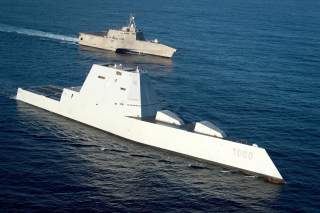The Navy's New Plans For a 355-Ship Battlefleet to Fight Russia and China
"Our Navy must continue to grow."
The United States Navy has completed its new 2016 Force Structure Assessment and the verdict is that the service needs to grow its battle fleet 47 ship and submarines. While the current plan called for a fleet of 308 ships, the new plan calls for a 355-ship fleet—including 12 aircraft carriers, 38 amphibious assault ships, 104 large surface combatants, 66 submarines, and 52 small surface combatants.
"To continue to protect America and defend our strategic interests around the world, all while continuing the counter terrorism fight and appropriately competing with a growing China and resurgent Russia, our Navy must continue to grow," said Ray Mabus, the outgoing Secretary of the Navy in a statement. "All of the analysis done to date, inside and outside of the Navy, recognizes, as we have for nearly the last eight years, the need for a larger Fleet. That is why, working with Congress and our partners in industry, we have successfully reversed the decline in shipbuilding that occurred from 2001-2009, putting 86 ships under contract over the last seven years. Maintaining this momentum, and the cost-saving business practices we have established, will be critical to ensuring the Navy is able to achieve the FSA-recommended fleet size and is positioned to maintain the global presence the Navy and Marine Corps uniquely provide our nation."
Mabus drafted the plan in anticipation of the incoming Trump Administration, which has promised to ramp up defense spending. Indeed, in drafting the new plan, Mabus had to defy the Secretary of Defense Ashton Carter—who had demanded the fiscal year 2018 budget conform to the Budget Control Act of 2011. The Navy, however, submitted a budget that is some $17 billion over those limits in anticipation of a more permissive spending environment when the new administration takes office on Jan. 20, 2017.
The Navy provided The National Interest with a summary of the 2016 FSA.
Table 1: Naval Battle Force Requirements
- Aircraft Carriers FY 2014: 11 FY 2016:12
- Large Surface Combatants FY 2014: 88 FY 2016:104
- Small Surface Combatants FY 2014: 52 FY 2016:52
- Amphibious Warfare Ships FY 2014: 34 FY 2016:38
- Attack Submarines FY 2014: 48 FY 2016:66
- Guided Missile Submarines FY 2014: 0 FY 2016:0
- Ballistic Missile Submarines FY 2014: 12 FY 2016:12
- Combat Logistics Force FY 2014: 29 FY 2016:32
- Expeditionary Fast Transport/High Speed Transport FY 2014: 10 FY 2016:10
- Expeditionary Support Base FY 2014: 3 FY 2016:6
- Command and Support FY 2014: 21 FY 2016:23
- Total FY 2014: 308 FY 2016:355
Table 1 displays the minimum force structure necessary to fulfill all of the Navy’s essential missions at an acceptable level of risk based on mission and threat projections. Notes:
1. The joint integrated campaign requirements along with an increase in sea based integrated air and missile defense drove the increase in Aircraft Carriers and Large Surface Combatants.
2. The increase in attack submarines results from the increased demand for global undersea capacity by COCOMs and leverages the Navy’s competitive advantage in the undersea domain.
3. Amphibious force structure is driven by the requirement of 38 total amphibious assault ships to support a 2.0 Marine Expeditionary Brigade (MEB) lift.
4.The additional Carrier, Large Surface Combatants and Amphibious Warships drove an increase in the supporting Combat Logistics Force.
5. The addition of 3 ESBs provide persistent and flexible capabilities for Counter Terrorism and Counter Illicit Trafficking efforts globally.
6. Additional T-AGOS were added to meet requirements for both sustained operations and crisis response in the Atlantic and Pacific.
The new Force Structure Assessment was well received on the Hill. Rep. Joe Courtney (D-CT), ranking member of the House Seapower and Projection Forces Subcommittee, was particularly pleased to see the requirement for attack submarines grow from 48 to 66. “I am particularly pleased that this plan reflects a larger attack submarine force structure. This reflects the reality that the demand for submarine capability, and their value to our national security objectives, is only going to increase,” Courtney said. “The feedback from military leaders who have routinely testified to me about the increasing demand for submarines in the Seapower Subcommittee, as well the sailors and officers I have spoken to about the pace and length of their deployments due to high operational demand on a overstressed fleet, confirms the findings of this analysis. This makes sustaining the two a year build rate as we also build the Columbia-class SSBN a national imperative, while also taking advantage of every possible opportunity to add to that build rate. I look forward to building on my bipartisan work to grow the submarine force and ensuring that the Navy has the tools and support it needs to get this done.”
More generally, Courtney said that a larger fleet is a necessity given the changing security environment around the globe. “The Navy’s new assessment is confirmation of the clear reality that a larger fleet is both necessary and vital to the nation’s security,” Courtney said. “Given the changing dynamics around the world, the growing demand for our ships, and the increasing strain on our fleet, I welcome this reassessment of our force structure requirements. This new fleet target will require the Navy, industry, and Congress to work together to build on the work we’ve done over the last several years to lay the groundwork for a larger fleet. If we are going to achieve the goal this plan calls for, we must continue to prioritize the funding, efficiencies, and authorities that will help us achieve it. I look forward to continuing to work with my colleagues in the House to achieve this important bipartisan goal.”
Dave Majumdar is the defense editor for The National Interest. You can follow him on Twitter: @davemajumdar.
Image: U.S. Navy

